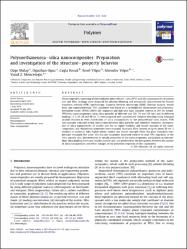Polyurethaneurea–silica nanocomposites: Preparation and investigation of the structure–property behavior
Künye
Malay, O., Oğuz, O., Koşak Söz, Ç., Yılgör, E., Yılgör, I., & Menceloğlu, Y. Z. (2013). Polyurethaneurea–silica nanocomposites: Preparation and investigation of the structure–property behavior. Polymer, 54(20), 5310-5320.Özet
Nanocomposites consisting of thermoplastic polyurethane–urea (TPU) and silica nanoparticles of various size and filler loadings were prepared by solution blending and extensively characterized by Fourier transform infrared (FTIR) spectroscopy, scanning electron microscopy (SEM), thermal analysis, tensile tests, and nanoindentation. TPU copolymer was based on a cycloaliphatic diisocyanate and poly(tetramethylene oxide) (PTMO-2000) soft segments and had urea hard segment content of 20% by weight. TPU/silica nanocomposites using silica particles of different size (29, 74 and 215 nm) and at different loadings (1, 5, 10, 20 and 40 wt. %) were prepared and characterized. Solution blending using isopropyl alcohol resulted in even distribution of silica nanoparticles in the polyurethane–urea matrix. FTIR spectroscopy indicated strong interactions between silica particles and polyether segments. Incorporation of silica nanoparticles of smaller size led to higher modulus and tensile strength of the nanocomposites, and elastomeric properties were retained. Increased filler content of up to about 20 wt. % resulted in materials with higher elastic moduli and tensile strength while the glass transition temperature remained the same. The fracture toughness increased relative to neat TPU regardless of the silica particle size. Improvements in tensile properties of the nanocomposites, particularly at intermediate silica loading levels and smaller particle size, are attributed to the interactions between the surface of silica nanoparticles and ether linkages of the polyether segments of the copolymers.

















